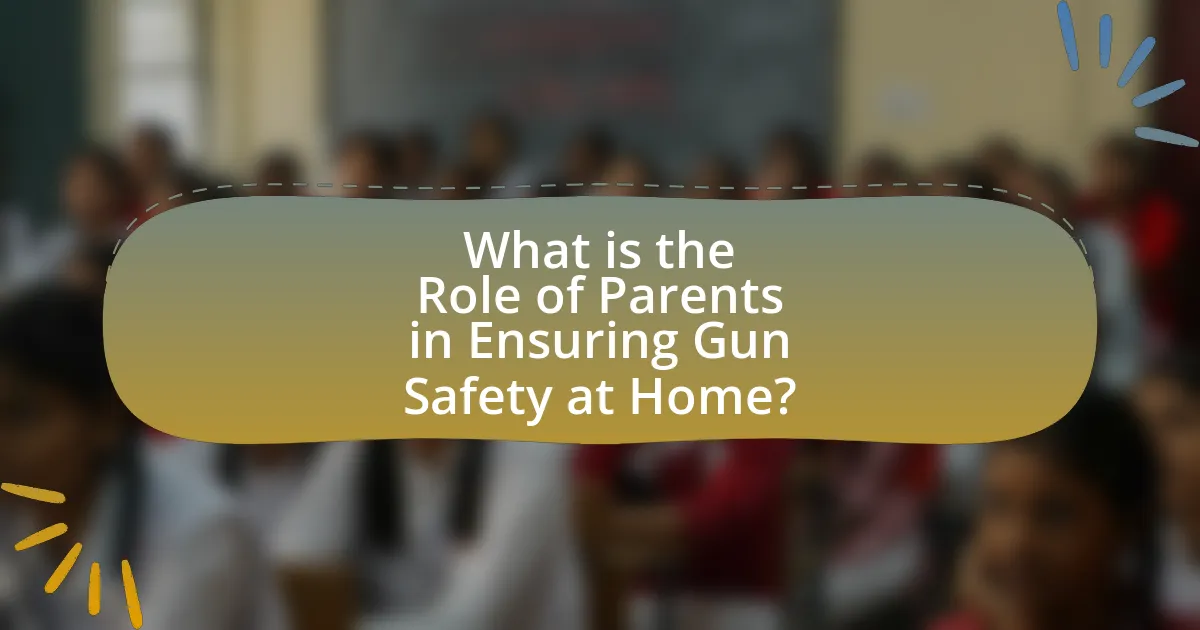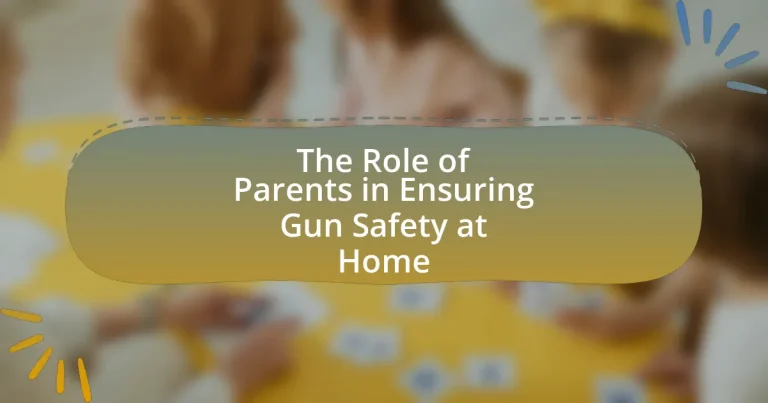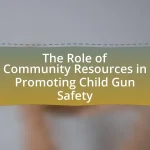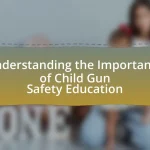The article focuses on the critical role of parents in ensuring gun safety at home. It emphasizes the importance of secure firearm storage practices and the need for parents to educate their children about the risks associated with firearms. Key statistics highlight the dangers of unsecured guns, revealing that millions of children live in homes with loaded and unlocked firearms, significantly increasing the risk of accidental shootings and suicides. The article outlines practical strategies for parents, including secure storage methods, open communication about gun safety, and available resources for education, while also addressing common misconceptions that may undermine safety practices.

What is the Role of Parents in Ensuring Gun Safety at Home?
Parents play a crucial role in ensuring gun safety at home by implementing strict storage practices and educating their children about firearm risks. They are responsible for securely storing firearms in locked cabinets or safes, which reduces the likelihood of unauthorized access. According to the American Academy of Pediatrics, approximately 1.7 million children live in homes with loaded and unlocked firearms, highlighting the need for proactive measures. Additionally, parents should engage in open discussions with their children about the dangers of guns, fostering an environment where children feel comfortable reporting any concerns. This dual approach of secure storage and education significantly decreases the risk of accidental shootings and promotes a culture of safety within the home.
Why is gun safety important for families?
Gun safety is crucial for families because it significantly reduces the risk of accidental shootings and injuries. According to the Centers for Disease Control and Prevention (CDC), in 2020, nearly 4,400 children aged 0-17 were killed or injured by firearms in the United States. Implementing gun safety measures, such as secure storage and education about firearm handling, can prevent these tragic incidents. Families that prioritize gun safety create a safer environment for children, thereby minimizing the potential for accidents and promoting responsible gun ownership.
What statistics highlight the risks of unsecured firearms in homes?
Unsecured firearms in homes significantly increase the risk of accidental shootings and suicides among children. According to the American Academy of Pediatrics, approximately 1 in 3 homes with children contain at least one firearm, and nearly 1 in 2 of those firearms are stored unlocked. Furthermore, research from the Journal of the American Medical Association indicates that children living in homes with unsecured guns are 8 times more likely to die from unintentional firearm injuries compared to those in homes where firearms are securely stored. Additionally, a study published in the New England Journal of Medicine found that access to firearms increases the risk of suicide among adolescents, with 90% of youth suicides involving a firearm occurring in homes where the gun was accessible. These statistics underscore the critical need for parents to ensure proper firearm storage to mitigate these risks.
How do children typically access firearms in unsafe environments?
Children typically access firearms in unsafe environments through inadequate storage practices by adults. Research indicates that approximately 4.6 million children live in homes with loaded and unlocked firearms, increasing the risk of access. In many cases, firearms are left in easily reachable places, such as nightstands or under beds, without proper safety measures like locks or safes. Additionally, children may gain access through peer influence, where they are encouraged to explore or handle firearms found in their homes or those of friends. This lack of secure storage and supervision contributes significantly to the potential for accidental shootings and misuse.
What responsibilities do parents have regarding gun safety?
Parents have the responsibility to ensure that firearms are stored securely and out of reach of children. This includes using gun safes, lockboxes, or trigger locks to prevent unauthorized access. According to the American Academy of Pediatrics, approximately 1.7 million children live in homes with loaded and unlocked firearms, highlighting the critical need for secure storage practices. Additionally, parents should educate their children about the dangers of guns and establish clear rules regarding firearm safety. This proactive approach can significantly reduce the risk of accidental shootings and promote a culture of safety within the home.
How can parents educate themselves about gun safety practices?
Parents can educate themselves about gun safety practices by accessing resources such as the National Rifle Association’s Eddie Eagle GunSafe Program, which provides educational materials for children and parents. Additionally, parents can attend local gun safety courses offered by certified instructors, which often include hands-on training and discussions about safe storage and handling of firearms. Research indicates that homes with a gun safety plan significantly reduce the risk of accidental shootings; for instance, a study published in the journal “Pediatrics” found that safe storage practices can lower the likelihood of firearm-related injuries among children.
What legal obligations do parents have concerning firearm storage?
Parents have a legal obligation to securely store firearms to prevent unauthorized access, particularly by minors. Many states have enacted laws requiring firearms to be stored in a locked container or with a locking mechanism to ensure safety. For example, California’s Child Access Prevention law mandates that firearms must be stored in a locked container if a child is likely to gain access to them. Failure to comply with these laws can result in criminal charges or civil liability if a child accesses the firearm and causes harm.
What strategies can parents implement to ensure gun safety at home?
Parents can implement several strategies to ensure gun safety at home, including securely storing firearms in locked cabinets or safes, using gun locks, and educating children about the dangers of guns. Secure storage prevents unauthorized access, significantly reducing the risk of accidental shootings; studies show that homes with locked firearms have lower rates of gun-related incidents. Additionally, using gun locks provides an extra layer of safety, as they render firearms inoperable when not in use. Education is crucial; parents should have open discussions with their children about gun safety, emphasizing that they should never touch a gun without adult supervision. These strategies collectively contribute to a safer home environment regarding firearms.
How can parents effectively communicate the dangers of guns to their children?
Parents can effectively communicate the dangers of guns to their children by engaging in open, honest discussions about gun safety and the potential consequences of gun misuse. Research indicates that children who receive clear, age-appropriate information about firearms are more likely to understand the risks associated with them. For instance, a study published in the journal “Pediatrics” found that children who participated in gun safety education programs demonstrated a better understanding of gun dangers compared to those who did not. Parents should also utilize real-life examples and statistics, such as the fact that in 2020, nearly 4,000 children in the U.S. were killed or injured by firearms, to emphasize the seriousness of the issue. Additionally, parents can model safe behavior by securely storing firearms and discussing the importance of never touching a gun without adult supervision.
What are the best practices for storing firearms securely?
The best practices for storing firearms securely include using a gun safe, locking devices, and ensuring proper storage conditions. A gun safe provides a secure environment that prevents unauthorized access, while locking devices, such as trigger locks, add an additional layer of safety. According to the National Shooting Sports Foundation, storing firearms in a locked safe reduces the risk of accidents and unauthorized use, particularly by children. Furthermore, maintaining a controlled environment, free from moisture and extreme temperatures, helps preserve the integrity of the firearms. These practices collectively enhance firearm safety at home, particularly in households with children.
How can parents assess their home for gun safety risks?
Parents can assess their home for gun safety risks by conducting a thorough inspection of their living environment, focusing on the storage and accessibility of firearms. They should ensure that all guns are stored in a locked safe or cabinet, inaccessible to children, and that ammunition is stored separately. Additionally, parents should evaluate the presence of any unsecured firearms in common areas and check that safety devices, such as trigger locks, are in place. According to the American Academy of Pediatrics, approximately 1.7 million children live in homes with loaded and unlocked guns, highlighting the importance of secure storage to prevent accidental shootings. Regularly reviewing and updating safety measures can further reduce risks associated with gun ownership in the home.
What specific areas in the home should parents evaluate for safety?
Parents should evaluate areas such as storage spaces, living rooms, bedrooms, and garages for safety. In storage spaces, firearms should be kept in locked cabinets or safes to prevent unauthorized access. Living rooms often contain accessible surfaces where firearms might be left unattended, increasing the risk of accidents. Bedrooms should be assessed for hidden firearm locations, ensuring that children cannot reach them. Garages may house tools and equipment that could be dangerous if misused alongside firearms. According to the American Academy of Pediatrics, secure storage of firearms significantly reduces the risk of unintentional shootings and suicides among children.
How can parents involve children in safety assessments?
Parents can involve children in safety assessments by engaging them in discussions about safety practices and encouraging them to identify potential hazards in their environment. This active participation helps children understand the importance of safety and empowers them to contribute to a safer home. Research indicates that children who are involved in safety discussions are more likely to retain safety information and apply it in real-life situations, enhancing their awareness and responsibility regarding safety measures.
What resources are available for parents to enhance gun safety knowledge?
Parents can enhance gun safety knowledge through various resources, including educational programs, online courses, and literature. Organizations such as the National Rifle Association (NRA) offer gun safety courses specifically designed for families, which cover safe storage practices and responsible handling. Additionally, the Eddie Eagle GunSafe Program, developed by the NRA, provides materials for parents to teach children about gun safety in a non-threatening manner. Research indicates that education significantly reduces the risk of accidental shootings; for instance, a study published in the Journal of the American Medical Association found that children who received gun safety training were less likely to engage in unsafe behaviors around firearms. Furthermore, local law enforcement agencies often provide community workshops focused on gun safety, making them accessible resources for parents.
Which organizations provide training and information on gun safety for families?
Organizations that provide training and information on gun safety for families include the National Rifle Association (NRA), the Eddie Eagle GunSafe Program, and the National Shooting Sports Foundation (NSSF). The NRA offers various educational resources and safety courses aimed at families, while the Eddie Eagle program specifically targets children to teach them how to avoid gun-related accidents. The NSSF promotes safe firearm handling and storage practices through its Project ChildSafe initiative, which distributes free gun locks and educational materials. These organizations are recognized for their commitment to enhancing gun safety awareness among families.
How can parents find local workshops or courses on gun safety?
Parents can find local workshops or courses on gun safety by searching online through resources such as the National Rifle Association (NRA) website, which offers a directory of certified training courses. Additionally, local law enforcement agencies often provide information on community safety programs, including gun safety workshops. Many community centers and shooting ranges also host gun safety courses, which can be found through their websites or by contacting them directly. According to the NRA, over 1,000 certified instructors are available nationwide, making it easier for parents to locate nearby training options.
What are some common misconceptions about gun safety at home?
Common misconceptions about gun safety at home include the belief that simply storing a firearm in a locked cabinet is sufficient to prevent accidents, and that children cannot access firearms if they are hidden. Research indicates that approximately 1.7 million children live in homes with unlocked guns, increasing the risk of unintentional shootings. Additionally, many people think that teaching children about guns will make them more curious and likely to handle them unsafely, while studies show that proper education can actually reduce the likelihood of accidents. These misconceptions can lead to inadequate safety measures and increased risks for families.
Why do some parents underestimate the importance of gun safety?
Some parents underestimate the importance of gun safety due to a lack of awareness about the risks associated with firearms in the home. Research indicates that approximately 4.6 million children live in homes with loaded and unlocked guns, which increases the likelihood of accidental shootings. Many parents may also believe that their children are not at risk or that they can rely on their parenting skills to prevent accidents, despite studies showing that children are naturally curious and may not fully understand the dangers of firearms. Additionally, cultural attitudes towards guns can lead to complacency regarding safety measures, as some parents may prioritize gun ownership rights over safety education.
How can addressing misconceptions improve safety practices?
Addressing misconceptions can significantly improve safety practices by enhancing understanding and compliance with safety protocols. When parents clarify misunderstandings about gun safety, such as the belief that simply storing firearms in a locked cabinet is sufficient, they can promote more comprehensive safety measures, including the use of gun safes and trigger locks. Research indicates that education on safe storage practices can reduce accidental shootings among children by up to 73% (source: The American Academy of Pediatrics). By correcting these misconceptions, parents foster a culture of safety that encourages responsible behavior and reduces risks associated with firearms in the home.
What practical tips can parents follow to promote gun safety at home?
Parents can promote gun safety at home by securely storing firearms in locked cabinets or safes, ensuring that they are inaccessible to children. Research indicates that 73% of children who live in homes with firearms know where the guns are stored, highlighting the importance of secure storage to prevent unauthorized access. Additionally, parents should educate their children about the dangers of guns and establish clear rules regarding their use. According to the American Academy of Pediatrics, discussing gun safety openly can significantly reduce the risk of accidental shootings. Regularly reviewing safety practices and involving children in discussions about responsible gun ownership further reinforces safe behaviors.


